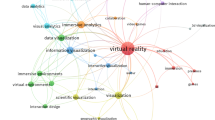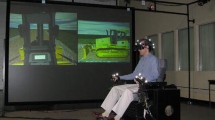Abstract
Interaction is the primary characteristic of a Virtual Environment and update rate is normally taken as an index or measure of the interactivity of the system. The speed of many systems is dictated by the slowest component which is often the Computer Image Generator (CIG). It is common for the workload of the CIG to vary and hence the performance of the system. This paper shows how a variable update rate can produce undesirable results. Two solutions to this problem are presented: service degradation and worst-case. In the case of the CIG, service degradation would require the quality of the image to be reduced such that the time taken never exceeds a given deadline. The worst-case technique works by finding the longest time taken to render any view and then uses that as the deadline for completion. The support of predictive methods is one of several benefits of this approach. An implementation of the worst-case technique is described which takes finer control over the CIG than usual and may be applied to many existing systems with little modification.
Similar content being viewed by others
References
Airey, J., Rohlf, J. and Brooks, F. (1990). Towards Image Realism with Interactive Updates Rates in Complex Virtual Building Environments.Computer Graphics 24(1): 41–50.
Barfield, W. and Hendrix, C. (1995). The Effect of Update Rate on the Sense of Presence within Virtual Environments.Virtual Reality: Research, Development and Applications 1(1): 3–16.
Dunnett, P., Harwood, R.M., Brookes, G.R. and Wills, D.P. (1995). Use of a Modified Kalman Filter for a Visually Coupled System Application.Virtual Reality: Research, Development and Applications 1(1): 57–68.
Friedmann, M. Starner, T. and Pentland, A. (1992). Synchronisation in Virtual Realities.Presence Teleoperators and Virtual Environments 1(1): 139–144.
Funkhouser, T. and Séquin, C. (1993). Adaptive Display Algorithm for Interactive Frame Rates During Visualization of Complex Virtual Environments. InProceedings of SIGGRAPH '93: 247–254.
Hawkes, R. (1993). The Virtual Environment Laboratory. InProceedings of the Virtual Reality Systems Conference '93, NY.
Holloway, R. (1992). Viper: A Quasi-Real-Time Virtual-Worlds Application.Technical Report TR92-004, UNC, Chapel Hill. ftp://ftp.cs.unc.edu/pub/techreports/92-004.tar.Z.
Lee, D.N. (1976). A theory of visual control of braking based on information about time to collision.Perception 5: 437–439.
Lee, D.N. (1993). Body-environment coupling IN Neisser U. (ed.)The perceived self: Ecological and interpersonal sources of self-knowledge (Cambridge University Press): 43–67.
Liang, J., Shaw, C. and Green, M. (1991). On Temporal-Spatial Realism in the Virtual Reality Environment. InProceedings of the 4th Annual Symposium on User Interface Software and Technology: 19–25.
Pausch, R., Crea, T. and Conway, M. (1992). A Literature Survey for Virtual Environments: Military Flight Simulator Visual Systems and Simulator Sickness.Presence Teleoperators and Virtual Environments 1(3): 344–363.
Permobil Meditech, Inc. (1993). Operating and Installation Manual for the Ober/2 12 bit Parallel System.
Reddy, M. (1995). A Survey of Level of Detail Support in Current Virtual Reality Solutions.Virtual Reality: Research, Development and Applications 1(2): 95–98.
SGI (1995) IRIS Performer Programmers Guide.
Shaw, C., Liang, J., Green, M. and Sun, Y. (1992). The decoupled simulation model for virtual reality systems. InProceedings of the CHI'92: 321–328.
UVa User Interface Group (1995) Alice: Rapid Prototyping for Virtual Reality.IEEE Computer Graphics & Applications 15(3): 8–11.
Wloka, M. (1993). Dissertation Proposal:Time Critical Graphics. Department of Computer Science, Brown University, Providence, Rhode Island. CS-93-50.
Author information
Authors and Affiliations
Rights and permissions
About this article
Cite this article
Hawkes, R., Rushton, S. & Smyth, M. Update rates and fidelity in virtual environments. Virtual Reality 1, 99–108 (1995). https://doi.org/10.1007/BF02009726
Issue Date:
DOI: https://doi.org/10.1007/BF02009726




